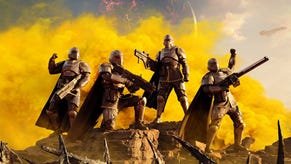Do players now value performance over graphical realism? | Opinion
Conventional wisdom is that graphical quality is more important but expectations may have shifted
Sign up for the GI Daily here to get the biggest news straight to your inbox
A friend sent me a pretty good meme this week.
It’s a picture of the scene from Iron Man where Jeff Bridges furiously pokes his finger into the chest of a hapless scientist, yelling that "Tony Stark was able to build this in a cave with a box of scraps!" – but in the meme version, Bridges is carrying a copy of Legend of Zelda: Tears of the Kingdom. It’s Nintendo that has built it in a cave with a box of scraps, and the scientist has Respawn Entertainment’s logo pasted on his white coat.
It got a laugh out of me; maybe you had to be there. It’s probably a lot less funny if you worked on the game the meme – and endless acres of Internet commentary – is taking aim at, Star Wars: Jedi Survivor, a keenly awaited sequel whose launch has been deeply soured by serious technical and performance issues.
The comparison, of course, is unfair in many regards. Tears of the Kingdom is Nintendo’s biggest game of the year and of crucial importance to the company’s platform; it was hardly built in a cave. You could make an argument for the box of scraps analogy, though, given that the game is running on a seven-year-old handheld device that wasn’t even cutting edge at launch.
There are a lot of reasons why TotK and Jedi Survivor perform so very differently, with optimisation and resourcing being arguably relatively minor on that list – but even given the very different goals, challenges, and priorities of these games, it is hard to ignore the final outcome.
One of them – running on a box of scraps – looks pretty great and plays smoothly and enjoyably. The other, running on the most advanced console hardware money can buy, is deeply technically compromised to the point where its performance failings make it significantly less enjoyable to play.
I’m still wary of the comparison – an open world RPG built around a complex physics sim and a Souls-lite based on Star Wars aren’t exactly an apples-to-apples pairing – but it’s worth digging into the question of why Jedi Survivor ended up this way, and I think the different priorities and decisions surrounding these two projects are important to consider.
We can and should dismiss from the outset the idea that the team at Respawn Entertainment somehow wasn’t capable of delivering a technically competent game – the studio’s track record makes it abundantly clear that that isn’t true.
Jedi Survivor was created by a supremely talented, world-class team; if the priority goal had been to deliver a game that hit clear performance goals, they would have done so. That they did not speaks to a different set of priorities and choices. Given the negativity surrounding the game since its launch, it’s worth asking what those priorities were and whether they were mistaken.
To be clear, that negative backlash is justified. Jedi Survivor deserves the criticism of its technical flaws – the game’s performance is very poor in a way that’s hugely damaging for the experience of a fast-paced action game. That issue is compounded by muddy, blocky visuals in many scenes, a consequence apparently of the game trying to preserve some semblance of a usable frame-rate by slashing its resolution targets and compensating with some fairly hideous upscaling, an unpleasant effect that can leave you wondering what, precisely, all that performance has been sacrificed for.
This is even before we get into the question of the game’s PC port – I’ve been playing on PS5 (or trying to, at least), but the accounts of the problems with the PC version suggest that it was a very low-priority and under-resourced effort. The problems here aren’t remotely at Cyberpunk 2077 levels – for the most part the game does work, and it is certainly feature-complete, but from a technical standpoint this is arguably the worst condition that a major AAA title has launched in since CD Projekt Red’s high-profile disaster.
If Respawn Entertainment are an extremely talented studio, which they are, then what set of priorities could result in a game launching in this state, while Nintendo’s ambitious, sprawling open world RPG runs just fine on a console roughly as powerful as an iPhone 8? First and foremost, there’s the focus on visuals.
That core priority – building a game that stands up alongside Star Wars’ live action properties – drives a cascading set of decisions that seep into every part of the game
The technical ambition of Jedi Survivor is very focused on visual fidelity, and while there will always be the soi-disant purists who insist that that doesn’t matter, it clearly matters very deeply to a lot of consumers. Much of the appeal of a AAA Star Wars game lies in the ability to give players the sense of exploring a world plucked from the franchise’s movies and TV shows; graphical quality is an incredibly important part of that.
Tears of the Kingdom benefits from the freedom to use a stylised and simplified visual style that lends itself to high performance and absolutely shines on smaller screens like an undocked Switch. Jedi Survivor never realistically had that option. There is certainly a world in which heavily stylised Star Wars games could be made and would be wonderful, but it is not an option that’s open to major AAA licensed titles right now.
That core priority – building a game that stands up alongside Star Wars’ live action properties – drives a cascading set of decisions that seep into every part of the game. It’s not just that Jedi Survivor wanted to make its environments look as realistic as possible, tapping into performance-sapping technologies like ray traced shadows and reflections to accomplish that goal – it also wanted its characters to be as perfectly matched to their actors as possible, using detailed performance capture and facial imaging.
Turning up the dial on those technologies also has a performance impact, but with the possibility that the actors might end up playing these characters in a live-action outing at some point no doubt floating around the conference rooms where decisions were being made, the priorities would have been set pretty easily. At every turn where a trade-off needed to be made, the overarching need to create a game that fits neatly into Star Wars’ live action canon would have dictated how those choices went.
These decisions would have been exacerbated by the looming shadow of Star Wars, but they are far from being unique to Jedi Survivor. At studios all around the industry, the trade-off between choosing to do things that look great in screenshots, trailers, and check-box feature lists, versus choosing to focus instead on something as dull and workmanlike as performance, is a tough thing to sell in a meeting where priorities are being set for the allocation of resources.

Given limited time and money, the possibility of doing something cool and new with ray tracing is going to seem like a better investment than focusing on hitting a consistent 60FPS or a high resolution target. Unless you’re actually a pretty devoted gamer, it can be very hard to understand the importance of something like framerate, and unless you’re very deep in the weeds about graphics technology, questions of resolution and upscaling will make your eyes glaze over.
This is going to come to a head in the next year or so, because we’re coming out of a very unusual era for game development. The transition from PS4 to PS5/XSX was highly irregular; supply chain issues, exacerbated by the pandemic, meant that supplies of the new consoles didn’t match demand for several years, and the PS4 remained effectively the dominant platform for quite some time after being superseded by new hardware.
That situation is finally turning around; supply has stabilised, installed bases have swelled, and the new consoles (which are not very new any more) are now in a market position where developers can start to leave the previous generation behind.
What this means is that for about three years, every major game has had to support PS4 in addition to the current consoles – a requirement which certainly held creators back from fully tapping the graphical potential of the new systems, but which also had the side-effect of ensuring that almost every major game that launched was optimised to work within the much more restrictive footprint of the PS4.
With the shackle of the PS4 SKU removed from around [Respawn's] ankle, that led to a game that’s insanely impressive in many regards – but let down hugely by its technical choices
On the new hardware, that often translated into having a performance mode that could lock the framerate to a solid 60FPS, often with relatively minimal sacrifices to graphical quality. Once a niche curiosity confined to fighting games and PC shooters, the ability to lock at 60FPS has become almost standard in the past few years – even if that’s been the case largely by accident due to the PS4’s unexpectedly long tail.
We are now seeing the first major game launches that don’t have an PS4 SKU – and the choices that has led to for Jedi Survivor, one of the first major third-party titles to ditch the previous generation hardware, do not fill me with hope for where this is leading.
Jedi Survivor does have a performance mode, but it’s actually choppier and more unpleasant to play than its 30FPS mode. Whether these issues are down to the choice to implement cutting-edge graphical features regardless of their impact on framerate and resolution performance, or to a failure to leave time and resources for optimisation, or a bit of both, this still boils down to a question of priorities.
It’s not that Respawn didn’t care about performance, they just didn’t care about it (or were instructed not to care about it) as much as they cared about other things. With the shackle of the PS4 SKU removed from around their collective ankle, that led to a game that’s insanely impressive in many regards – but let down hugely by its technical choices.
Perhaps there is a commercial logic to these decisions. I can see the arguments – gorgeous trailers and screenshots, and breathless hype around using cutting-edge new features, will all combine to sell far more games than concerns over something as technical and dull as framerate performance could ever counterbalance. (It doesn’t help that there’s a whole echelon of senior people in the industry who learned decades ago that movies run at 24FPS and have considered any advance beyond that to be nonsense and technobabble ever since.)
Yet for three years we’ve had generally smooth, 60FPS games with crisp, clean, high-resolution graphics – albeit sacrificing some realism for that goal – and I can’t help but wonder if consumers, having experienced that possibility, will be remotely as forgiving of bad performance as they used to be. If consumer expectations have truly shifted, then EA and Respawn have been wrong-footed quite badly, and many other companies are likely to experience the same thing.
The past few years gave consumers a glimpse of what games could be like if developers were allowed to ease back on the ceaseless pursuit of graphical fidelity and focus instead on consistent performance and resolution – and having experienced that, a lot of consumers may not be willing to go back to how things were.
Sign up for the GI Daily here to get the biggest news straight to your inbox



-Jussi-Ratilainen.jpg?width=291&height=164&fit=crop&quality=80&format=jpg&auto=webp)





